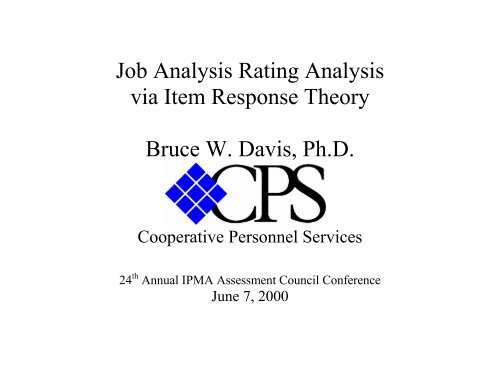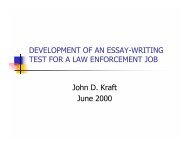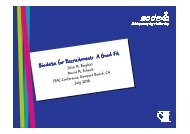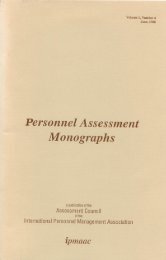Job Analysis Rating Analysis via Item Response Theory - IPAC
Job Analysis Rating Analysis via Item Response Theory - IPAC
Job Analysis Rating Analysis via Item Response Theory - IPAC
You also want an ePaper? Increase the reach of your titles
YUMPU automatically turns print PDFs into web optimized ePapers that Google loves.
<strong>Job</strong> <strong>Analysis</strong> <strong>Rating</strong> <strong>Analysis</strong><strong>via</strong> <strong>Item</strong> <strong>Response</strong> <strong>Theory</strong>Bruce W. Davis, Ph.D.Cooperative Personnel Services24 th Annual IPMA Assessment Council ConferenceJune 7, 2000
Importance of <strong>Job</strong> <strong>Analysis</strong>• Court Cases• Uniform Guidelines on Employee Selection Procedures(1978)• Principles for the Validation and Use of PersonnelSelection Procedures (1987)• Standards for Educational and Psychological Testing(1999)Conclusion – Necessary but not sufficient practice formany personnel programs
Despite Importance …• Perceived as means to an end• Measurement error• Social and cognitive biases (Morgeson & Campion,1997)• Limited guidance concerning scale selection orcombination• Little research into the appropriateness of job analysisscale anchors• Limited research concerning job analysis data into testplan
Current Study …• Firefighter physical agility test development• Task based job analysis• Importance and Frequency scales• Questionnaire completed by incumbents and immediatesupervisors• Provide alternate method of examining job analysisresults
Why <strong>Item</strong> <strong>Response</strong> <strong>Theory</strong>?• Rasch Measurement Model• Respondents and <strong>Item</strong>s calibrated on same scale ofmeasurement• Compare items and persons• True interval properties (scale points)• Additional information about activities and respondents
Method• Physical agility test development• Task and ability inventory focused on 55 tasks• 141 respondents (engineers, captains, lieutenants)• Confirmatory approach (link existing “events” to jobanalysis results)• WinSteps software program
ResultsTwo assumptions of Rasch model:1. Unidimensionality2. Local IndependenceData fit the model relatively well:Principal components analysis of residuals (Linacre,1998)One dimension accounted for 64% of variance
Summary of Measured Persons (Person Reliability .96)RawModelScore Count Measure ErrorMean 83.8 54.2 .06 .20s.d. 36.8 4.7 1.25 .10Max. 161.0 55.0 4.04 1.27Min. 1.0 1.0 -3.29 .17INFITOUTFITMNSQ ZSTD MNSQ ZSTDMean 1.04 -.3 1.04 -.3s.d. .50 2.5 .49 2.3Max. 2.80 7.3 2.86 7.0Min. .00 -6.6 .00 -5.4
Summary of Measured <strong>Item</strong>s (<strong>Item</strong> Reliability .96)RawModelScore Count Measure ErrorMean 214.7 138.9 .00 .12s.d. 48.8 1.3 .68 .01Max. 315.0 141.0 2.00 .14Min. 78.0 133.0 -1.38 .11INFITOUTFITMNSQ ZSTD MNSQ ZSTDMean 1.01 -.7 1.05 -.5s.d. .55 3.7 .63 3.7Max. 3.03 9.9 3.16 9.9Min. .41 -6.9 .46 -5.6
Missfitting <strong>Item</strong>s#21 Removes, carries, and maneuvers, straightladders, extension ladders, roof ladders, pole ladders,attic ladders, and A-Frame unassisted (3.06);50403020100notimportantsomewhatimportantimportantveryimportantmiss
#12 Locates Hidden Fire by Feeling walls and ceilingor by smelling fire (3.03);806040200notimportantsomewhatimportantimportantveryimportantmiss
# 6 Lifts and carries SCBA's. (3.16)50403020100notimportantsomewhatimportantimportantveryimportantmiss
PERSONSMAP OF ITEMS|4 X +|||||3 +||XXX T||XX |2 XXX + Locates hidden fire by feeling walls and ceilingX | Unfolds fire shelter and covers oneself in it …X |XXXXX |XXXXXXXX S|TXXXX | Constructs fire line in grassy area by scraping…1 XXXXXXX + Mai StaXXXXXXXXXXX | Cli RemXXXXXXXXX |S WalXXXXXX | Ope Pro SmoXXXXXXX | Con Con Cut Ign Jum Rel Sit Tra Wal WalXXXX |0 XXXXXXX M+M Cli Cre Ent Jum Rai Use WalXXXXXXXXXX | Car Car Con Cut Lif Res UseXXXX | Cli Hoi Mov Phy Sta UsiXXXX | Car Dri Dri RemXXXX |S Car Hoi MovXXXXXXXXX | Car Mak Rol-1 XXXXXX + Drags victims … Drives emergency medical …XXX S| Carries equipment and hose to upper floors …XXXXXXX |T Extinguishes grass fires with shovel or rake.XXXX |X |X |-2 X +XX ||XXX T|X ||-3 X +|X ||||-4 +|
ITEMSMAP OF PERSONS|4 + ltt (35-44 yrs, 1-3 yrs class, 7-9 yrs exp)|||||3 + 1 (45-54 yrs, 10> yrs class, 10> yrs exp)| 2 (35-44 yrs, 1-3 yrs class, 10> yrs exp)| 3 (35-44 yrs, 4-6 yrs class, 7-9 yrs exp)T| eng 1 ltt 2 ltt 3|| cap ltt2 X + eng ltt lttX | eng| ltt| cap cap cap ltt lttS|T cap cap eng ltt ltt ltt ltt lttX | cap eng ltt ltt1 XX + cap eng eng eng ltt ltt lttXX | cap cap eng eng eng eng eng ltt ltt lttlttX |S cap cap cap eng eng eng ltt ltt lttXXX | cap cap eng eng eng engXXXXXXXXXX | eng eng eng eng ltt ltt ltt| cap eng ltt ltt0 XXXXXXX M+M cap cap eng eng eng eng lttXXXXXXX | cap cap eng eng eng eng ltt ltt ltt lttXXXXXX | eng eng eng lttXXXX | cap eng eng engXXX |S eng eng ltt lttXXX | cap eng eng eng eng eng ltt ltt ltt-1 XX + cap eng eng eng ltt lttX S| eng eng engX |T eng eng eng eng ltt ltt ltt| cap eng eng ltt| eng| ltt-2 + eng| eng eng|T| cap eng ltt| eng (45-54 yrs, 10> yrs class, 10> yrs exp)|-3 + cap (55> yrs, 7-9 yrs class, 10> yrs exp)|| ltt (55> yrs, 10> yrs class, 10> yrs exp)|||-4 +|
EXPECTED SCORE: MEAN (":" INDICATES HALF-SCORE POINT)-4 -3 -2 -1 0 1 2 3 4 5|-----+-----+-----+-----+-----+-----+-----+-----+-----| NUM ITEM0 0 : 1 : 2 : 3 3 12 Locates hidden fire by feeling walls and ceil0 0 : 1 : 2 : 3 3 55 Unfolds fire shelter and covers oneself in it0 0 : 1 : 2 : 3 3 49 Constructs fire line in brush or wooded area0 0 : 1 : 2 : 3 3 34 Stands for more than half of shift while perf0 0 : 1 : 2 : 3 3 42 Maintains balance on narrow or uneven surface0 0 : 1 : 2 : 3 3 6 Climbs or crawls through confined spaces0 0 : 1 : 2 : 3 3 25 Removes ventilation fans or smoke ejectors0 0 : 1 : 2 : 3 3 35 Walks for more than half of shift while perf0 0 : 1 : 2 : 3 3 26 Probes with pike poles to determine if roof0 0 : 1 : 2 : 3 3 48 Operates portable hand operated pump to extin0 0 : 1 : 2 : 3 3 53 Smothers fire or potential fire restart areas0 0 : 1 : 2 : 3 3 36 Walks up and down stairs in a multiple story0 0 : 1 : 2 : 3 3 54 Ignites unburned areas within break lines0 0 : 1 : 2 : 3 3 37 Walks up and down rough terrain (e.g., hills)0 0 : 1 : 2 : 3 3 50 Transports wildland firefightighting equip0 0 : 1 : 2 : 3 3 19 Reloads hoses, nozzles, and other equipment0 0 : 1 : 2 : 3 3 33 Sits for more than half of shift while perfor0 0 : 1 : 2 : 3 3 52 Cuts limbs, snags, brush, trees, etc. using0 0 : 1 : 2 : 3 3 51 Constructs fire line in a grassy area by scra0 0 : 1 : 2 : 3 3 32 Constructs fire line in a grassy area with ha0 0 : 1 : 2 : 3 3 41 Jumps down from high objects (e.g., 6 ft fenc0 0 : 1 : 2 : 3 3 7 Walks or crawls along joists where balance an0 0 : 1 : 2 : 3 3 40 Jumps down from low objects (e.g., window led0 0 : 1 : 2 : 3 3 22 Raises and lowers straight ladders, extension0 0 : 1 : 2 : 3 3 23 Creates ventilation openings by forcing doors0 0 : 1 : 2 : 3 3 38 Climbs up to elevated surfaces (e.g., roof)0 0 : 1 : 2 : 3 3 28 Uses axe to cut hole through roof0 0 : 1 : 2 : 3 3 8 Enters, walks, or crawls throu0 0 : 1 : 2 : 3 3 5 Rescues drowning persons by swimmming and usi0 0 : 1 : 2 : 3 3 46 Lifts and carries SCBA's.0 0 : 1 : 2 : 3 3 29 Uses pulling and prying tools (pike pole, pla0 0 : 1 : 2 : 3 3 14 Carries or drags charged hose lines to fire0 0 : 1 : 2 : 3 3 31 Constructs fire line in brush or wooded area0 0 : 1 : 2 : 3 3 30 Cuts or pries open vehicles, machinery, or0 0 : 1 : 2 : 3 3 43 Carries objects or equipment (e.g., ax, hose0 0 : 1 : 2 : 3 3 44 Physically reacts to sounds, signs, signals0 0 : 1 : 2 : 3 3 39 Climbs through small openings, such as window0 0 : 1 : 2 : 3 3 27 Starts and operates chain saw
EXPECTED SCORE: MEAN (":" INDICATES HALF-SCORE POINT)-4 -3 -2 -1 0 1 2 3 4 5|-----+-----+-----+-----+-----+-----+-----+-----+-----| NUM ITEM0 0 : 1 : 2 : 3 3 18 Hoists hose sections and other equipment usin0 0 : 1 : 2 : 3 3 24 Using hooks or hangars, remove ventilation fa0 0 : 1 : 2 : 3 3 1 Moves and carries heavy objects, equipment or0 0 : 1 : 2 : 3 3 3 Carries or assists conscious, unconscious, or0 0 : 1 : 2 : 3 3 20 Drives apparatus according to state and local0 0 : 1 : 2 : 3 3 11 Drives emergency medical vehicle to transport0 0 : 1 : 2 : 3 3 21 Removes, carries, and maneuvers, straight0 0 : 1 : 2 : 3 3 10 Moves victims from scene to ambulance, corona0 0 : 1 : 2 : 3 3 2 Carries equipment from emergency scene; cuts0 0 : 1 : 2 : 3 3 4 Hoists and lowers victims, tools, and equip0 0 : 1 : 2 : 3 3 16 Makes and unmakes hose connections to water0 0 : 1 : 2 : 3 3 15 Carries or drags empty hose lines to fire sce0 0 : 1 : 2 : 3 3 13 Rolls or folds hose sections; carries to and0 0 : 1 : 2 : 3 3 45 Drives for extended periods of time (> 15 min0 0 : 1 : 2 : 3 3 9 Drags victims while crouched low.0 0 : 1 : 2 : 3 3 17 Carries equipment and hose to upper floors of00 : 1 : 2 : 3 3 47 Extinguishes grass fires with shovel or rake.|-----+-----+-----+-----+-----+-----+-----+-----+-----| NUM ITEM-4 -3 -2 -1 0 1 2 3 4 5
MOST MISFITTING RESPONSE STRINGSITEM OUTMNSQ |PERSON| 1 1 11 11 1 1 1 1 1|674 185399392503 7663711 216232 41 723418542220207|94747918761135653640251281622771466100092709013629high--------------------------------------------------46 Lifts and 3.16 A|....1.....0...00.0.....3 33..333333.33333.33.2...2carries SCBA’s.21 Removes, 3.06 B|........011..000.00..........333333.33.33333.3.2.2carries, and maneuvers, straight ladders, extension ladders roof ladders,pole ladders, attic ladders, and A-frame ladders unassisted.12 Locates hidden 3.03 C|.00.............3..323.32.......213...2.......1...fire by feeling walls and ceiling or by smelling fire.1 Moves and 2.27 D|22.1.1.1..............................3..2..2.3.32carries heavy objects, equipment or materials to gain access to or tofree trapped victims or bodies.
CATEGORY PROBABILITIES: MODES - Step measures atintersectionsP ++---------+---------+---------+---------+---------+---------++R 1.0 + +O | |B | |A |00 33|B .8 + 000 333 +I | 00 333 |L | 00 33 |I | 00 33 |T .6 + 00 3 +Y | 00 33 |.5 + 00 33 +O | *11111111111 22222222223 |F .4 + 111 00 1**2 33222 +| 111 00 22 11 33 222 |R | 11 0 22 11 3 222 |E | 111 0*2 ** 222 |S .2 + 111 222 00 33 11 222 +P |111 222 000 333 111 222|O | 222 33*00 1111 |N | 2222222 333333 000000 1111111 |S .0 +********33333333333333 000000000000000*******+E ++---------+---------+---------+---------+---------+---------++-3 -2 -1 0 1 2 3PERSON [MINUS] ITEM MEASURE
GUTTMAN SCALOGRAM OF RESPONSES:PERSON| ITEM|41 4111 1212 21234433124 22234 435531535354232 43451|7795356420110314879430149658823807121239074638655624952|-------------------------------------------------------69 +333333333333332333333333333333333333333333333333033333374 +333333333333332333333333333233333 333333333333033 3101047 +3333333333313223332333333333333332333333333333232033310103 +001010011101013000000000001100000100000000000000010000126 +1100011000201010000000010100000000000000010100010001000102 +000 000000000030000 000000000000000110010101100000010079 +0000000000200020000000000200000000000000000000010001000|-------------------------------------------------------|4194111421212312123443312458222347435531535354232643451|77 5356 0110 48794301496 82380 121239074638655 24952
<strong>Item</strong> 47 -- Extinguishes grass fires with shovel or rake. (1)<strong>Item</strong> 17 -- Carries equipment and hose to upper floors of buildings(2)<strong>Item</strong> 9 -- Drags victims while crouched low (3)<strong>Item</strong> 49 -- Constructs fire line in brush or wooded area using abrush hook, Pulaski, or double bit axe. (53)<strong>Item</strong> 55 -- Unfolds fire shelter and covers oneself in it whennormal exits from a fire are blocked in order to shield oneself fromadvancing heat and flame. (54)<strong>Item</strong> 12 -- Locates hidden fire by feeling walls and ceiling or bysmelling fire. (55)
Conclusions• Rasch model assumes interval properties (only way to examinedata)• <strong>Job</strong> analysis Guidelines:• Limited guidance regarding how to measure• No guidance regarding how to analyze• Benefits of IRT• Additional means of analyzing data• Provides additional information beyond means and standardde<strong>via</strong>tions• Method of assessing utility of scale anchors• Possibility of adaptive job analysis questionnaires
Contact InformationBruce Davis, Ph.D.241 Lathrop WayCooperative Personnel ServicesSacramento, CA 95815Phone: (916) 263-3624 ext. 3067Fax: (916) 561-7267e-mail: bruce@cps.ca.govWebsite: www.cps.ca.gov
Scale discriminates between the persons well.<strong>Item</strong>s create a well defined variable (.96).Outfit Mean of -.3 indicates less than expected; and more variability in the fit of these persons asexpected.Review outliers in summary statistics.<strong>Item</strong> outfit of -.5 responses are more consistent than the model expects. S.D. suggests that there aresome misfitting items.
















